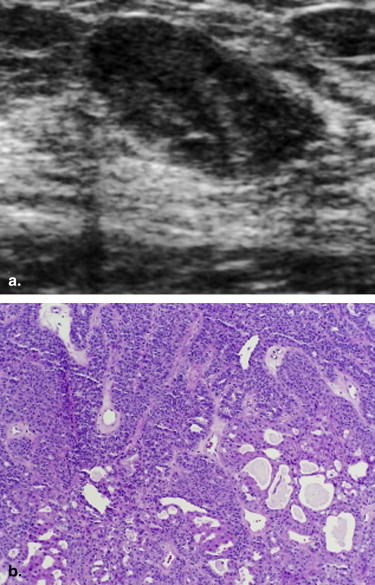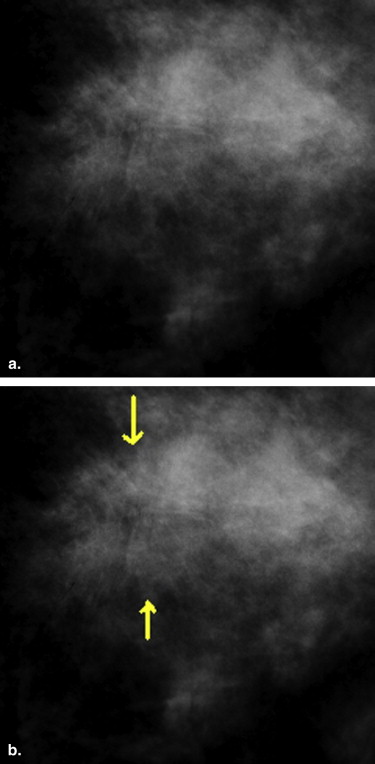Rationale and Objectives
The aim of this study was to determine if core biopsy–proven benign papillomas of the breast need to be surgically excised.
Materials and methods
Mammographic and pathologic database review from January 1994 to January 2004 revealed 178 papillary lesions diagnosed by core biopsy in 176 women (mean age, 59 years). All lesions had ≥24 months of imaging follow-up ( n = 75) or surgical correlation ( n = 103). Details regarding core biopsy technique, lesion appearance, pathologic results, imaging-histopathologic concordance, and follow-up imaging were recorded. Core and surgical pathologic results were correlated.
Results
Of the 178 papillary lesions diagnosed at core needle biopsy, 120 (67%) were initially diagnosed as benign without atypia. The core biopsy diagnoses of benignity were confirmed for all 120 lesions by either surgical excision ( n = 45) or stability after ≥2 years of imaging follow-up ( n = 75). Of the remaining 58 papillary lesions, 50 were found to be atypical at core needle biopsy; 15 of those 50 (29%) were upgraded to malignancies at surgical excision. Eight of the 178 lesions (5%) were initially diagnosed as malignant papillary lesions at core needle biopsy. Seven of these eight (88%) were confirmed malignant at excision. None of the surgically proven cancers was diagnosed as benign at core biopsy.
Conclusions
Close imaging follow-up rather than excision of core biopsy–proven benign papillomas was adequate given careful imaging-histopathologic correlation and excision of all atypical and discordant lesions. Individual centers should evaluate their own data and tailor their practices accordingly.
It is standard practice to surgically excise all papillary lesions of the breast with malignant or atypical features at percutaneous core needle biopsy . However, the management of benign papillomas without atypia after image-guided core biopsy remains controversial. Several investigators have asserted that in the appropriate setting, papillomas diagnosed as benign at core needle biopsy can be safely followed . Others have recommended that all papillary lesions be surgically excised because of a concern that core biopsy may undersample potential foci of atypia or malignancy . Additionally, it can be challenging for pathologists to histologically differentiate benign papillomas, which have a uniform myoepithelial cell layer, from papillary carcinomas, in which this layer is often absent .
At our institution, benign papillomas without atypia diagnosed at core needle biopsy are followed with imaging to ensure stability over time. Excision is performed only if the imaging and histologic results are discordant or if there is a change, such as increased size or the development of additional calcifications, on follow-up imaging. The purpose of this retrospective study was to determine whether this practice of careful histopathologic correlation and 2 years of imaging follow-up is adequate for papillomas diagnosed as benign at core biopsy.
Materials and methods
Patients and Lesions
Get Radiology Tree app to read full this article<
Get Radiology Tree app to read full this article<
Data Collection
Get Radiology Tree app to read full this article<
Biopsy
Get Radiology Tree app to read full this article<
Pathology
Get Radiology Tree app to read full this article<
Concordance
Get Radiology Tree app to read full this article<
Follow-up
Get Radiology Tree app to read full this article<
Get Radiology Tree app to read full this article<
Results
Core Needle Biopsy and Surgical Pathologic Results
Get Radiology Tree app to read full this article<
Get Radiology Tree app to read full this article<
Get Radiology Tree app to read full this article<
Table 1
Summary of Core Biopsy and Surgical Pathologic Results
Surgical Result Core Result Benign Atypical Malignant Total Benign 44 1 0 45 Atypical 21 14 15 50 Malignant 1 0 7 8 Total 66 15 22 103
Get Radiology Tree app to read full this article<
Papillary Lesions with Core Biopsy Diagnoses of Benignity That Underwent Surgical Excision
Get Radiology Tree app to read full this article<
Table 2
Benign Lesions at Core Biopsy with Surgical Correlation
Surgical Result Reason for Surgery Benign Atypical Malignant Total Change on follow-up imaging 7 ∗ 0 0 7 Radiologic-pathologic discordance 5 0 0 5 Additional high-risk or malignant lesion 25 0 0 25 Pathology recommendation 3 1 0 4 Patient/physician preference 4 0 0 4 Total 44 1 0 45
Get Radiology Tree app to read full this article<
Get Radiology Tree app to read full this article<
Get Radiology Tree app to read full this article<
Get Radiology Tree app to read full this article<
Get Radiology Tree app to read full this article<
Discussion
Get Radiology Tree app to read full this article<
Get Radiology Tree app to read full this article<
Get Radiology Tree app to read full this article<
Get Radiology Tree app to read full this article<
Get Radiology Tree app to read full this article<
Get Radiology Tree app to read full this article<
Get Radiology Tree app to read full this article<
Get Radiology Tree app to read full this article<
Get Radiology Tree app to read full this article<
Get Radiology Tree app to read full this article<
Get Radiology Tree app to read full this article<
References
1. Rosen E.L., Bentley R.C., Baker J.A., Soo M.S.: Imaging-guided core needle biopsy of papillary lesions of the breast. AJR Am J Roentgenol 2002; 179: pp. 1185-1192.
2. Sydnor M.K., Wilson J.D., Hijaz T.A., et. al.: Underestimation of the presence of breast carcinoma in papillary lesions initially diagnosed at core-needle biopsy. Radiology 2007; 242: pp. 58-62.
3. Mercado C.L., Bena D.H., Oken S.M., et. al.: Papillary lesions of the breast at percutaneous core-needle biopsy. Radiology 2006; 238: pp. 801-808.
4. Liberman L., Tornos C., Huzjan R., et. al.: Is surgical excision warranted after benign, concordant diagnosis of papilloma at percutaneous breast biopsy?. AJR Am J Roentgenol 2006; 186: pp. 1328-1334.
5. Philpotts L.E., Shaheen N.A., Jain K.S., et. al.: Uncommon high-risk lesions of the breast diagnosed at stereotactic core-needle biopsy: clinical importance. Radiology 2000; 216: pp. 831-837.
6. Mercado C.L., Hamele-Bena D., Singer C., et. al.: Papillary lesions of the breast: evaluation with stereotactic directional vacuum-assisted biopsy. Radiology 2001; 221: pp. 650-655.
7. Liberman L., Bracero N., Vuolo M.A., et. al.: Percutaneous large-core biopsy of papillary breast lesions. AJR Am J Roentgenol 1999; 172: pp. 331-337.
8. Renshaw A.A., Derhagopian R.P., Tizol-Blanco D.M., Gould E.W.: Papillomas and atypical papillomas in breast core needle biopsy specimens. risk of carcinoma in subsequent excision. Am J Clin Pathol 2004; 122: pp. 217-221.
9. Valdes E.K., Feldman S.M., Boolbol S.K.: Papillary lesions: a review of the literature. Ann Surg Oncol 2007; 14: pp. 1009-1013.
10. Tavassoli F.A.: Papillary lesions.Pathology of the breast.1999.Appleton & LangeStamford, CT:pp. 325-372.
11. Christiansen C.L., Wang F., Barton M.B., et. al.: Predicting the cumulative risk of false positive mammograms. J Natl Cancer Inst 2000; 92: pp. 1657-1666.

